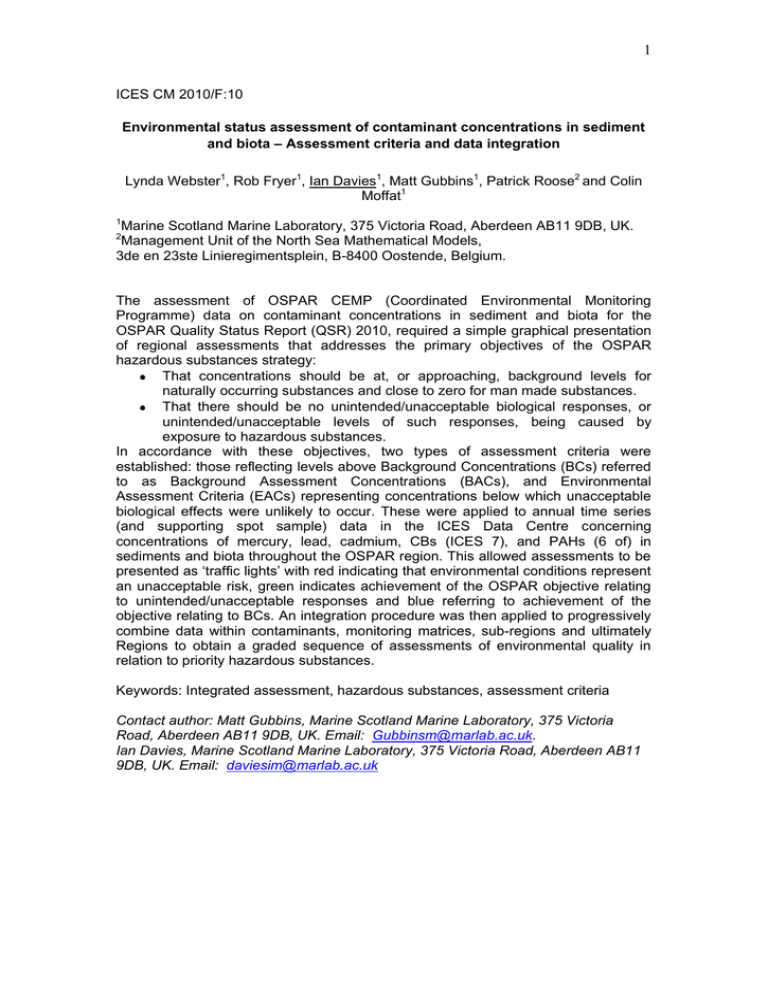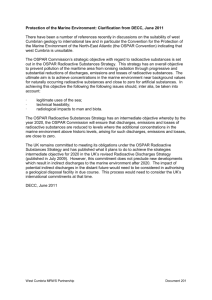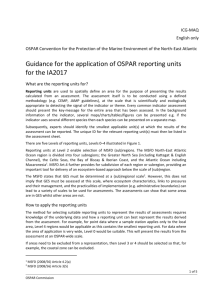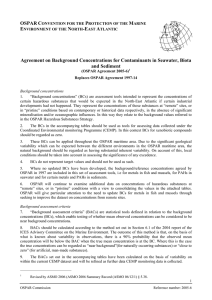1
advertisement

1 ICES CM 2010/F:10 Environmental status assessment of contaminant concentrations in sediment and biota – Assessment criteria and data integration Lynda Webster1, Rob Fryer1, Ian Davies1, Matt Gubbins1, Patrick Roose2 and Colin Moffat1 1 Marine Scotland Marine Laboratory, 375 Victoria Road, Aberdeen AB11 9DB, UK. Management Unit of the North Sea Mathematical Models, 3de en 23ste Linieregimentsplein, B-8400 Oostende, Belgium. 2 The assessment of OSPAR CEMP (Coordinated Environmental Monitoring Programme) data on contaminant concentrations in sediment and biota for the OSPAR Quality Status Report (QSR) 2010, required a simple graphical presentation of regional assessments that addresses the primary objectives of the OSPAR hazardous substances strategy: That concentrations should be at, or approaching, background levels for naturally occurring substances and close to zero for man made substances. That there should be no unintended/unacceptable biological responses, or unintended/unacceptable levels of such responses, being caused by exposure to hazardous substances. In accordance with these objectives, two types of assessment criteria were established: those reflecting levels above Background Concentrations (BCs) referred to as Background Assessment Concentrations (BACs), and Environmental Assessment Criteria (EACs) representing concentrations below which unacceptable biological effects were unlikely to occur. These were applied to annual time series (and supporting spot sample) data in the ICES Data Centre concerning concentrations of mercury, lead, cadmium, CBs (ICES 7), and PAHs (6 of) in sediments and biota throughout the OSPAR region. This allowed assessments to be presented as „traffic lights‟ with red indicating that environmental conditions represent an unacceptable risk, green indicates achievement of the OSPAR objective relating to unintended/unacceptable responses and blue referring to achievement of the objective relating to BCs. An integration procedure was then applied to progressively combine data within contaminants, monitoring matrices, sub-regions and ultimately Regions to obtain a graded sequence of assessments of environmental quality in relation to priority hazardous substances. Keywords: Integrated assessment, hazardous substances, assessment criteria Contact author: Matt Gubbins, Marine Scotland Marine Laboratory, 375 Victoria Road, Aberdeen AB11 9DB, UK. Email: Gubbinsm@marlab.ac.uk. Ian Davies, Marine Scotland Marine Laboratory, 375 Victoria Road, Aberdeen AB11 9DB, UK. Email: daviesim@marlab.ac.uk 2 Introduction In preparing an assessment of OSPAR CEMP monitoring data on contaminant concentrations in fish, shellfish and sediment for the OSPAR Quality Status Report (QSR) 2010 project, there was a requirement to produce very succinct, graphical presentations of assessments. Data should be integrated to provide assessments/summaries at OSPAR Region level, and address OSPAR objectives for hazardous substances, ie, That concentrations should be at, or approaching, background levels for naturally occurring substances and close to zero for man made substances. That there should be no unintended/unacceptable biological responses, or unintended/unacceptable levels of such responses, being caused by exposure to hazardous substances. Approach a) Monitoring data: The monitoring data available to the assessment group consisted primarily of a large number of time series data (annual) for contaminant concentrations in sediment, fish and shellfish from national programmes covering the OSPAR Convention area (c.f OSPAR, 2009a). These were supported by various numbers of spot samples from stations that had been sampled less regularly. All the data were held by the ICES Data Centre, and included Quality Assurance information (such as scores from Laboratory Performance Studies and analyses of reference materials) to allow assessments of the relative quality of the monitoring data. The data included in the assessment covered analyses of sediment, fish and shellfish for mercury, lead, cadmium, CBs (ICES7 congeners), and PAHs (6 off) from a large number of stations throughout the OSPAR Convention area. a) Assessment criteria: Integrated assessment requires that numerical assessment criteria are available to apply to the monitoring data and that these criteria are philosophically consistent across contaminants and monitoring matrices. In keeping with the two primary objectives of the OSPAR Strategy for Hazardous Substances stated above, two types of assessment criteria were sought: those reflecting background concentrations (BCs/BACs), and others (Environmental Assessment Criteria, EACs) representing concentrations below which unacceptable biological effects were unlikely to occur. In practice, background concentrations, and associated background assessment concentrations, were available for these priority substances, or could be developed in time for the QSR. However, this was not the case for all EACs, and some different approaches were necessary to complete the suite of assessment criteria. These approaches included the use of some Effects Range Low (ERL) values for sediments, and the development of EACs for CBs in sediment that reflected new understanding of the availability of CBs in sediment derived from passive sampling studies (OSPAR, 2009b. The resulting list of “EACs” was considered to reflect contaminant concentrations in sediment and biota that presented unacceptable risk, corresponding to the failure to achieve statutory targets or policy objectives for contaminants in these matrices. Tabulations of the values of the assessment criteria used are included at Annex 1 to this paper. The assessment criteria used for each contaminant/matrix combination are listed in Table 1, and the values are tabulated in OSPAR, 2009b. c) Data integration 3 An outcome of this approach to data assessment was that data assessments could be described through a three colour “traffic light” scheme, in which the upper transition (green to red, T1) indicates that the target/objective has been achieved; i.e “red” indicates that environmental conditions represent an unacceptable risk. The lower transition (represented as a blue-green, T0) refers to achievement of the OSPAR objective in relation to background concentrations. Table 1 Summary of transition points for assessing contaminants in sediment and biota for the OSPAR CEMP Assessment. T0 = blue/green transition; T1 = green/red or amber/red transition. Contaminant PAH CB Metal Transition Point T0 T1 T0 T1 T0 T1 Sediment BAC ERL BAC EAC BAC ERL Biota BAC EAC BAC EACpassive BAC EC An integration procedure was then applied to progressively combine data within contaminants, monitoring matrices, sub-regions and ultimately Regions to obtain a graded sequence of assessments of environmental quality in relation to priority hazardous substances. Extensive integration of data was necessary to develop the succinct, graphical presentations required for the OSPAR QSR 2010 process. Integration proceeded in a stepwise manner. Methods were developed to ensure that as much of the underlying information as possible was retained through the process, and that it was possible to trace back through the data manipulations to clarify the reasons underlying any features in the integrated presentations. a) Step 1: The first step in the data assessment was to undertake assessments of the data for temporal trends, by fitting LOESS smoothers to the data (OSPAR, 2008). This identified those data series for individual contaminants, in individual matrices, at individual stations in which significant linear or non-linear trends had occurred. The process also returned the fitted values in the final year of each time series, and the uncertainty in these values. These values were then compared to assessment criteria (EACs and BACs), and the outcomes of these assessments were expressed in a traffic light system. In turn, this information was presented in maps showing the results of assessment for each station by contaminant, and by matrix (eg, Fig 1). These maps were used to show both significant trends and comparisons of concentrations with assessment criteria. 4 Fig 1 Fitted final year concentrations of two PAHs in sediment and biota, and indications of significant temporal trends. b) Step 2: While the priority metals, Hg, Cd and Pb are treated as individual hazardous substances in OSPAR, the CBs and PAHs are considered as groups. The initial data analysis provided assessments for each CB congener and each PAH separately. To provide a balanced basis for further integration of data, it was necessary to summarise the assessments for CBs and PAHs down to single assessment, by matrix, by station. A “one out all out” approach was considered for this, but was rejected as it was thought to be too susceptible to possible uncertainties in either the data or the assessment criteria, and a “two out all out” approach was used, and found to be more satisfactory and less easily influenced by uncertainties in data. This step had the benefit if ensuring that subsequent data presentations would not be distorted by the multiple determinands used in the CB and PAH groups. The data were now structured by stations, contaminants and matrices. All have been summarised as traffic light scheme assessments. The traffic light assessments against BAC and EAC were taken forward into a summarising/ integration process. c) Step 3 The next step was to define geographical sub-areas for which integrated assessments would be made. It was recognized that there were differences in environmental quality within OSPAR Regions. The most consistent pattern within OSPAR Regions was between near shore and offshore areas, with generally higher levels of contamination being found in near shore waters. Therefore, an assessment framework of subdivisions for each OSPAR Region was based upon a large offshore 5 area, and a small number (up to 4) of inshore areas consisting of coastal sea waters within the 12 nautical mile boundary. Fig 2: Subdivisions of the OSPAR area used in contaminant data assessment for the QSR 2010, showing offshore areas, and coastal waters defined by the 12 nautical mile limit, in OSPAR Regions I-IV. The colours are of no significance, but are included to improve clarity of the map. d) Step 4: The next stage in the integration process was to combine data within contaminants, across stations within assessment sub-areas. This was done by calculating the percentages of blue, green and red station assessments, by contaminant, in each sub-area. Assessments based on time series were given twice the weight of spot samples. These results were displayed as histograms superimposed in maps of each OSPAR Region. Various different presentations can be envisaged. The version shown in Fig CCC shows proportions of blue, green and red assessments, for each contaminant, in each sub-area. It therefore integrates across stations and across matrices. The upper horizontal bar for each sub-area integrates across contaminants as well to give an overall expression of environmental quality for each sub-area for the five priority contaminants or groups of contaminants used in the assessment. 6 Figure 3: Display of data integration across sub-areas for 5 contaminants. Figure for 2.0 Figure for 2.1 Region 2 offshore Sub-region 2.1 Sub-region 2.3 Figure for 2.3 Figure for 2.4 Sub-region 2.4 Sub-region 2.2 Figure for 2.2 e) Step 5: The final step was to combine data across across sub-areas within Regions to obtain Region-scale assessments. This was done by averaging the sub-area assessments within each Region. The final presentation used in the draft WSR document (Fig 4) allows comparisons to be made of environmental quality for each contaminant within a Region, and also individual contaminants across Regions. 7 Figure 4: Integrated assessment of hazardous substances in the OSPAR regions The overall summary assessment, by Region (Figure 4) demonstrates that a proportion of red (unacceptable) assessments are still found in all OSPAR Regions. The most frequent occurrences of unacceptable (red) assessments are for the organic contaminants CBs and PAHs. Lower frequencies were found for the metals Cd, Pb and Hg, but there are considerable differences between regions and subregions. The highest proportions of acceptable assessments are found in the Arctic area, where 38% of the assessments indicated that concentrations were at background values. The data indicate that conditions in waters to the west of the UK (Region III) and particularly in the North Sea (Region II) are less good than in regions I and IV. Where statistically significant Regional-level trends were found (Regions III, IV, and particularly in Region II) they are all downwards, indicating patterns of progressive improvement in conditions in most parts of the Convention area. The most frequent occurrences of background concentrations are for the metals, particularly for Cd and Pb. Generally, very few examples can be found of areas where the organic contaminant groups (CBs, and PAHs) have achieved background concentrations. There are clear indications of downward trends in the concentrations of these substances in biota, but rather less so in sediment. It is likely that fish and shellfish will respond more rapidly than seabed sediments to regulatory measures. Outputs from intermediate stages of the integration process were also available to the QSR process and enabled comparisons to be made between inshore and offshore areas within Regions, and also between adjacent inshore areas (subregions). 8 Conclusions Integrated assessments can provide new insights into the relative significance of environmental contaminants, and comparative levels of contamination between marine areas on the scale of OSPAR Regions. Robust integrated assessments are strongly dependent on the availability of assessment criteria which correspond to equivalent levels of environmental risk. Information is progressively lost as the level of integration increases, and therefore documentation should incorporate traceability back through lower levels of integration to the underlying monitoring data. References OSPAR, 2008. CEMP Assessment Manual: Co-ordinated Environmental Monitoring Programme Assessment Manual for contaminants in sediment and biota. OSPAR Publication No 379, OSPAR, London OSPAR, 2009a. CEMP assessment report: 2008/2009 Assessment of trends and concentrations of selected hazardous substances in sediments and biota. OSPAR Publication No 390, OSPAR, London OSPAR, 2009b. Background Document on CEMP Assessment Criteria for the QSR 2010. OSPAR Publication No 461, OSPAR, London



